Modeling and Design of a Novel 5-DOF AC–DC Hybrid Magnetic Bearing
Abstract
:1. Introduction
2. Structure and Working Principle
3. Mathematical Model
Equivalent Magnetic Circuit
4. Magnetic Analysis
4.1. Magnetic Flux Analysis
4.2. Suspension Force Analysis
4.3. Displacement–Force–Current Analysis
5. Conclusions
Author Contributions
Funding
Institutional Review Board Statement
Informed Consent Statement
Data Availability Statement
Conflicts of Interest
Nomenclature
| Fm | Magnetomotive force of the left and right permanent magnets (A) |
| ϕlm | Total fluxes of the left permanent magnets (Wb) |
| ϕrm | Total fluxes of the right permanent magnets (Wb) |
| Glpz | Left-inclined axial air-gap permeances (H) |
| Grpz | Right-inclined axial air-gap permeances (H) |
| GlA | Left radial air-gap permeances in the A direction (H) |
| GlB | Left radial air-gap permeances in the B direction (H) |
| GlC | Left radial air-gap permeances in the C direction (H) |
| Gra | Right radial air-gap permeances in the A direction (H) |
| GrB | Right radial air-gap permeances in the B direction (H) |
| GrC | Right radial air-gap permeances in the C direction (H) |
| ϕlpz | Left axial bias fluxes (Wb) |
| ϕrpz | Right axial bias fluxes (Wb) |
| ϕlpA | Left radial bias fluxes in the A direction (Wb) |
| ϕlpB | Left radial bias fluxes in the B direction (Wb) |
| ϕlpC | Left radial bias fluxes in the C direction (Wb) |
| ϕrpA | Right radial bias fluxes in the A direction (Wb) |
| ϕrpB | Right radial bias fluxes in the B direction (Wb) |
| ϕrpC | Right radial bias fluxes in the C direction (Wb) |
| xl | Left displacements in the X direction (m) |
| yl | Left displacements in the Y direction (m) |
| xr | Right displacements in the X direction (m) |
| yr | Right displacements in the Y direction (m) |
| z | Displacement in the Z direction (m) |
| μ0 | Vacuum permeability (md) |
| Sr | Radial pole face area( m2) |
| Sa | Axial pole face area (m2) |
| dr | Average radial air gap (m) |
| da | Axial inclined air-gap length (m) |
| θ | Angle of the inclined axial pole |
| ϕlkA | Left radial control fluxes in the A direction (Wb) |
| ϕlkB | Left radial control fluxes in the B direction (Wb) |
| ϕlkC | Left radial control fluxes in the C direction (Wb) |
| ϕrkA | Right radial control fluxes in the A direction (Wb) |
| ϕrkB | Right radial control fluxes in the B direction (Wb) |
| ϕrkC | Right radial control fluxes in the C direction (Wb) |
| ϕlkz | Left axial control fluxes (Wb) |
| ϕrkz | Right axial control fluxes (Wb) |
| Nl | Numbers of the left radial coil turns |
| Nr | Numbers of the right radial coil turns |
| ilA | Current in the A direction left radial coil (A) |
| ilB | Current in the B direction left radial coil (A) |
| ilC | Current in the C direction left radial coil (A) |
| irA | Current in the A direction right radial coil (A) |
| irB | Current in the B direction right radial coil (A) |
| irC | Current in the C direction right radial coil (A) |
| Nz | Number of the axial coil turns on one side |
| iz | Axial control currents (A) |
| ϕlA | Left radial air-gap fluxes in the A direction (Wb) |
| ϕlB | Left radial air-gap fluxes in the B direction (Wb) |
| ϕlC | Left radial air-gap fluxes in the C direction (Wb) |
| ϕrA | Right radial air-gap fluxes in the A direction (Wb) |
| ϕrB | Right radial air-gap fluxes in the B direction (Wb) |
| ϕrC | Right radial air-gap fluxes in the C direction (Wb) |
| ϕz1 | Left axial air-gap fluxes (Wb) |
| ϕz2 | Right axial air-gap fluxes (Wb) |
| Fz | Force in the Z direction (N) |
| FlA | Left forces in the A direction (N) |
| FlB | Left forces in the B direction (N) |
| FlC | Left forces in the C direction (N) |
| FrA | Right forces in the A direction (N) |
| FrB | Right forces in the B direction (N) |
| FrC | Right forces in the C direction (N) |
| kfd | Axial force-displacement stiffness (N/m) |
| kia | Axial force–current stiffness (N/m) |
| Flp | Magnetic forces of the magnets in the left radial air gaps at the equilibrium position (N) |
| Frp | Magnetic forces of the magnets in the right radial air gaps at the equilibrium position (N) |
| klir | Left radial force–current stiffness (N/m) |
| krir | Right radial force–current stiffness (N/m) |
| Flx | Left resultant forces in the X directions (N) |
| Fly | Left resultant forces in the Y direction (N) |
| Frx | Right resultant forces in the X direction (N) |
| Fry | Right resultant forces in the Y direction (N) |
| Fm | Magnetomotive force of the left and right permanent magnets (A) |
| AC | Alternating current |
| DC | Direct current |
| DOF | Degree of freedom |
| MB | Magnetic bearings |
| FEM | Finite element method |
| HMB | Hybrid magnetic bearings |
| FEA | Finite element analysis |
References
- Sun, X.; Chen, L.; Jiang, H.; Yang, Z.; Chen, J.; Zhang, W. High-Performance Control for a Bearingless Permanent-Magnet Synchronous Motor Using Neural Network Inverse Scheme Plus Internal Model Controllers. IEEE Trans. Ind. Electron. 2016, 63, 3479–3488. [Google Scholar] [CrossRef]
- Noshadi, A.; Shi, J.; Lee, W.S.; Shi, P.; Kalam, A. System Identification and Robust Control of Multi-Input Multi-Output Active Magnetic Bearing Systems. IEEE Trans. Control Syst. Technol. 2015, 24, 1227–1239. [Google Scholar] [CrossRef]
- Sun, X.; Shi, Z.; Chen, L.; Yang, Z. Internal Model Control for a Bearingless Permanent Magnet Synchronous Motor Based on Inverse System Method. IEEE Trans. Energy Convers. 2016, 31, 1539–1548. [Google Scholar] [CrossRef]
- Peng, C.; Fang, J.; Xu, X. Mismatched Disturbance Rejection Control for Voltage-Controlled Active Magnetic Bearing via State-Space Disturbance Observer. IEEE Trans. Power Electron. 2014, 30, 2753–2762. [Google Scholar] [CrossRef]
- Sun, X.; Su, B.; Chen, L.; Yang, Z.; Xu, X.; Shi, Z. Precise control of a four degree-of-freedom permanent magnet biased active magnetic bearing system in a magnetically suspended direct-driven spindle using neural network inverse scheme. Mech. Syst. Signal Process. 2017, 88, 36–48. [Google Scholar] [CrossRef]
- Sun, X.; Chen, L.; Yang, Z. Overview of Bearingless Permanent-Magnet Synchronous Motors. IEEE Trans. Ind. Electron. 2012, 60, 5528–5538. [Google Scholar] [CrossRef]
- Zhu, W.; Zhang, T.; Le, Q.; Wang, Z. A novel five-degree-of-freedom AC-DC hybrid magnetic bearing. AIP Adv. 2020, 10, 015034. [Google Scholar] [CrossRef]
- Zhang, T.; Ye, X.; Mo, L.; Zhang, C.; Lu, Q.; Ding, Z.; Ni, W. Modeling and performance analysis on the five degrees of freedom slice hybrid magnetic bearing. IEEE Trans. Appl. Supercond. 2017, 29, 1–5. [Google Scholar]
- Zhang, W.; Zhu, H. Radial magnetic bearings: An overview. Results Phys. 2017, 7, 3756–3766. [Google Scholar] [CrossRef]
- Noh, M.D.; Cho, S.-R.; Kyung, J.-H.; Ro, S.-K.; Park, J.-K. Design and Implementation of a Fault-Tolerant Magnetic Bearing System for Turbo-Molecular Vacuum Pump. IEEE/ASME Trans. Mechatron. 2005, 10, 626–631. [Google Scholar] [CrossRef]
- Lee, J.-H.; Allaire, P.; Tao, G.; Decker, J.; Zhang, X. Experimental study of sliding mode control for a benchmark magnetic bearing system and artificial heart pump suspension. IEEE Trans. Control Syst. Technol. 2003, 11, 128–138. [Google Scholar] [CrossRef]
- Kosaka, R.; Nishida, M.; Maruyama, O.; Yambe, T.; Imachi, K.; Yamane, T. Effect of a bearing gap on hemolytic property in a hydrodynamically levitated centrifugal blood pump with a semi-open impeller. Bio-Medical Mater. Eng. 2013, 23, 37–47. [Google Scholar] [CrossRef] [PubMed]
- Sun, X.; Chen, L.; Yang, Z.; Zhu, H. Speed-Sensorless Vector Control of a Bearingless Induction Motor With Artificial Neural Network Inverse Speed Observer. IEEE/ASME Trans. Mechatron. 2012, 18, 1357–1366. [Google Scholar] [CrossRef]
- Jin, Z.; Sun, X.; Chen, L.; Yang, Z. Robust Multi-Objective Optimization of a 3-Pole Active Magnetic Bearing Based on Combined Curves With Climbing Algorithm. IEEE Trans. Ind. Electron. 2021, 69, 5491–5501. [Google Scholar] [CrossRef]
- Zhu, H.; Ju, J. Development of Three-pole Magnetic Bearings and Key Technologies. Proc. CSEE 2014, 34, 1360–1367. [Google Scholar]
- Zhu, H.; Zhao, Z. Decoupling Control Based on Linear/Nonlinear Active Disturbance Rejection Switching for 3-degree-of-freedom 6-pole Hybrid Magnetic Bearing. Proc. CSEE 2017, 38, 3077–3086. [Google Scholar]
- Le, Y.; Sun, J.; Han, B. Modeling and Design of 3-DOF Magnetic Bearing for High-Speed Motor Including Eddy-Current Effects and Leakage Effects. IEEE Trans. Ind. Electron. 2016, 63, 3656–3665. [Google Scholar] [CrossRef]
- Jin, Z.; Sun, X.; Cai, Y.; Zhu, J.; Lei, G.; Guo, Y. Comprehensive Sensitivity and Cross-Factor Variance Analysis-Based Multi-Objective Design Optimization of a 3-DOF Hybrid Magnetic Bearing. IEEE Trans. Magn. 2020, 57, 1–4. [Google Scholar] [CrossRef]
- Sun, J.; Ju, Z.; Peng, C.; Le, Y.; Ren, H. A Novel 4-DOF Hybrid Magnetic Bearing for DGMSCMG. IEEE Trans. Ind. Electron. 2016, 64, 2196–2204. [Google Scholar] [CrossRef]
- Sun, X.; Jin, Z.; Chen, L.; Yang, Z. Disturbance rejection based on iterative learning control with extended state observer for a four-degree-of-freedom hybrid magnetic bearing system. Mech. Syst. Signal Process. 2021, 153, 107465. [Google Scholar] [CrossRef]
- Tezuka, T.; Kurita, N.; Ishikawa, T. Design and Simulation of a Five Degrees of Freedom Active Control Magnetic Levitated Motor. IEEE Trans. Magn. 2013, 49, 2257–2262. [Google Scholar] [CrossRef]
- Xu, S.; Sun, J. A new structure for heteropolar permanent magnet biased radial magnetic bearing with subsidiary air gap. IEEE Trans. Magn. 2014, 50, 830–848. [Google Scholar] [CrossRef]
- Weissbacher, C.; Stelzer, H.; Hameyer, K. Application of a Tubular Linear Actuator as an Axial Magnetic Bearing. IEEE/ASME Trans. Mechatron. 2009, 15, 615–622. [Google Scholar] [CrossRef]
- Shi, Z.; Sun, X.; Lei, G.; Tian, X.; Guo, Y.; Zhu, J. Multiobjective Optimization of a Five-Phase Bearingless Permanent Magnet Motor Considering Winding Area. IEEE/ASME Trans. Mechatron. 2021. [Google Scholar] [CrossRef]
- Sun, X.; Jin, Z.; Wang, S.; Yang, Z.; Li, K.; Fan, Y.; Chen, L. Performance Improvement of Torque and Suspension Force for a Novel Five-Phase BFSPM Machine for Flywheel Energy Storage Systems. IEEE Trans. Appl. Supercond. 2019, 29, 1–5. [Google Scholar] [CrossRef]
- Sun, X.; Xue, Z.; Zhu, J.; Guo, Y.; Yang, Z.; Chen, L.; Chen, J. Suspension Force Modeling for a Bearingless Permanent Magnet Synchronous Motor Using Maxwell Stress Tensor Method. IEEE Trans. Appl. Supercond. 2016, 26, 1–5. [Google Scholar] [CrossRef]
- Sun, X.; Jin, Z.; Cai, Y.; Yang, Z.; Chen, L. Grey Wolf Optimization Algorithm Based State Feedback Control for a Bearingless Permanent Magnet Synchronous Machine. IEEE Trans. Power Electron. 2020, 35, 13631–13640. [Google Scholar] [CrossRef]
- Schweitzer, G. Magnetic Bearings Theory, Design, and Application to Rotating Machinery; Springer: Berlin/Heidelberg, Germany, 1989. [Google Scholar]
- Chen, S.; Song, M. Energy-Saving Variable Bias Current Optimization for Magnetic Bearing Using Adaptive Differential Evolution. In International Conference on Swarm Intelligence; Springer: Cham, Switzerland, 2017. [Google Scholar]
- Lijesh, K.P.; Hirani, H. Optimization of Eight Pole Radial Active Magnetic Bearing. J. Tribol. 2015, 137, 024502. [Google Scholar] [CrossRef]
- Le, Y.; Wang, K. Design and Optimization Method of Magnetic Bearing for High-Speed Motor Considering Eddy Current Effects. IEEE/ASME Trans. Mechatron. 2016, 21, 2061–2072. [Google Scholar] [CrossRef]
- Han, B.; Xu, Q.; Zheng, S. Integrated radial/thrust magnetic bearing without thrust disk for a high-speed driving system. IET Electr. Power Appl. 2016, 10, 276–283. [Google Scholar] [CrossRef]
- Hoffman, W. Behaviour and control of an inverter-fed three-pole active radial magnetic bearing. In Proceedings of the 2003 IEEE International Symposium on Industrial Electronics, Rio de Janeiro, Brazil, 9–11 June 2003; pp. 974–979. [Google Scholar]
- Yang, H.; Zhao, R.; Tang, Q. Study on inverter-fed three-pole active magnetic bearing. In Proceedings of the 21st Annual IEEE Applied Power Electronics Conference and Exposition, Dallas, TX, USA, 19–23 March 2006; pp. 1576–1581. [Google Scholar]
- Gu, H.; Zhu, H.; Hua, Y. Soft Sensing Modeling of Magnetic Suspension Rotor Displacements Based on Continuous Hidden Markov Model. IEEE Trans. Appl. Supercond. 2017, 28, 3600105. [Google Scholar] [CrossRef]
- Park, S.-H.; Lee, C.-W. Decoupled Control of a Disk-Type Rotor Equipped With a Three-Pole Hybrid Magnetic Bearing. IEEE/ASME Trans. Mechatron. 2009, 15, 793–804. [Google Scholar] [CrossRef]
- Bakay, L.; Dubois, M.; Viarouge, P.; Ruel, J. Losses in an optimized 8-pole radial AMB for Long Term Flywheel Energy Storage. In Proceedings of the 2009 International Conference on Electrical Machines and Systems (ICEMS), Tokyo, Japan, 15–18 November 2009. [Google Scholar]
- Hofer, M.; Schmidt, E.; Schrodl, M. Design of a three phase permanent magnet biased radial active magnetic bearing regarding a position sensorless control. In Proceedings of the 2009 Twenty-Fourth Annual IEEE Applied Power Electronics Conference and Exposition (APECE), Washington, DC, USA, 15–19 February 2009. [Google Scholar]
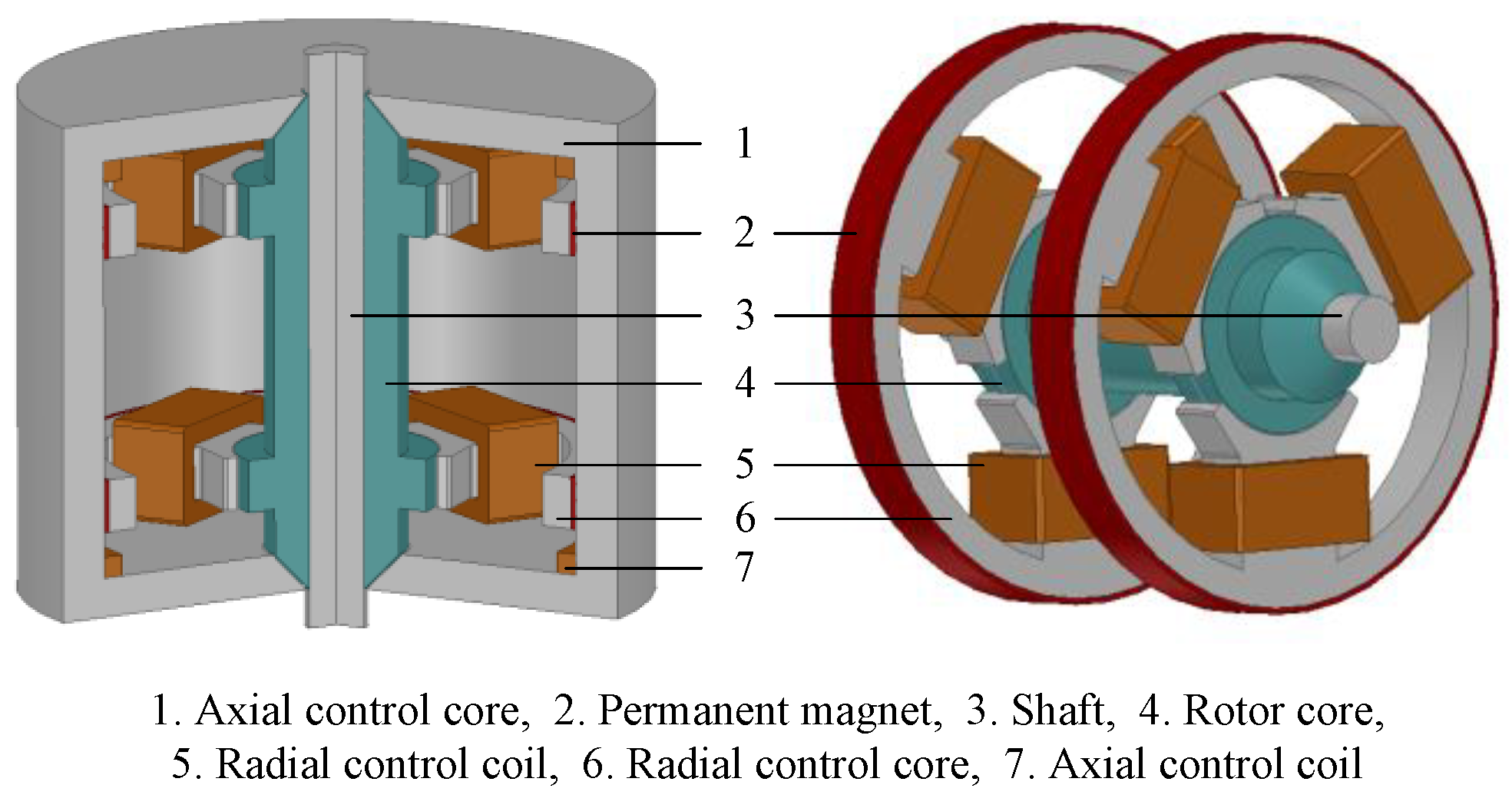
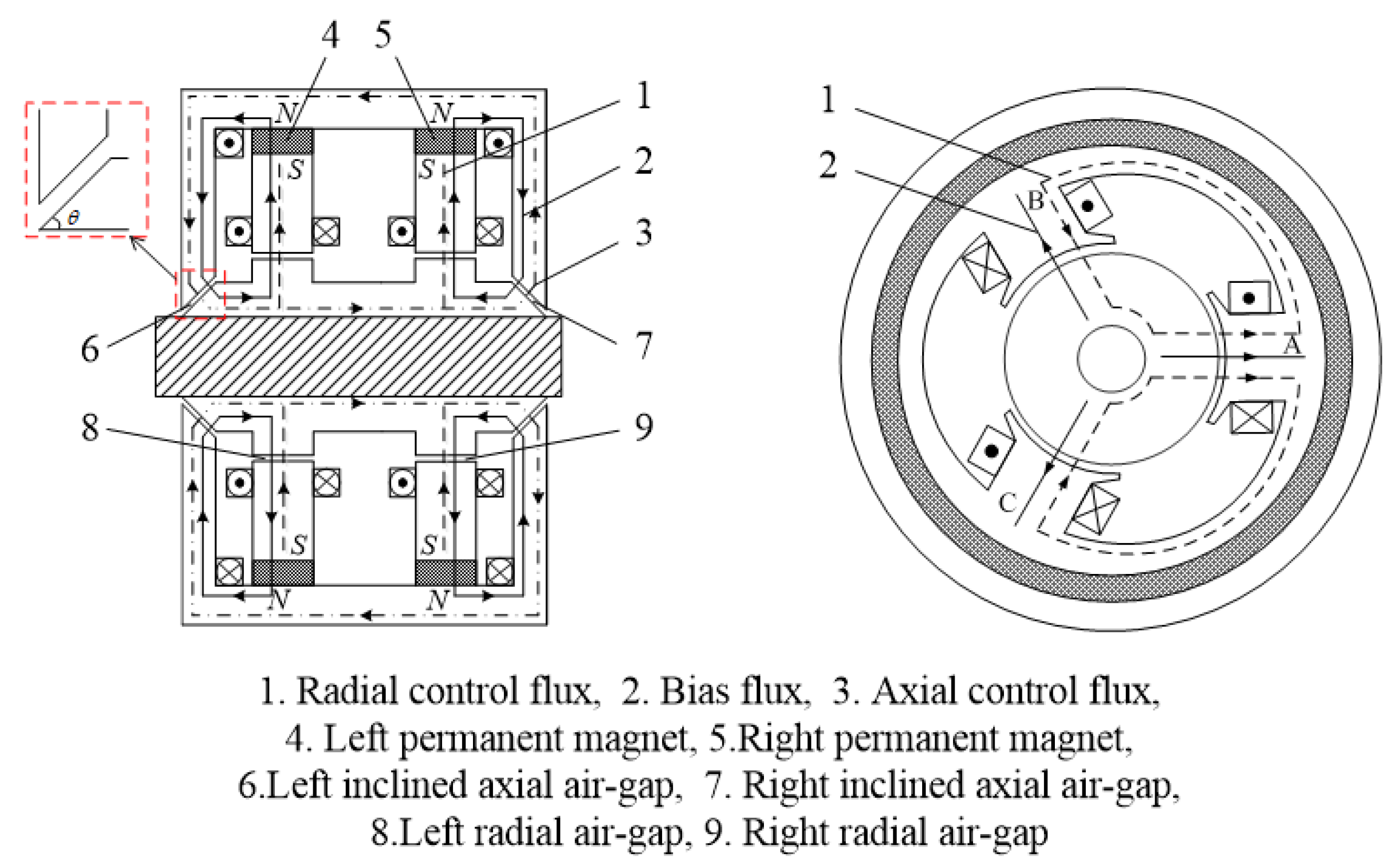
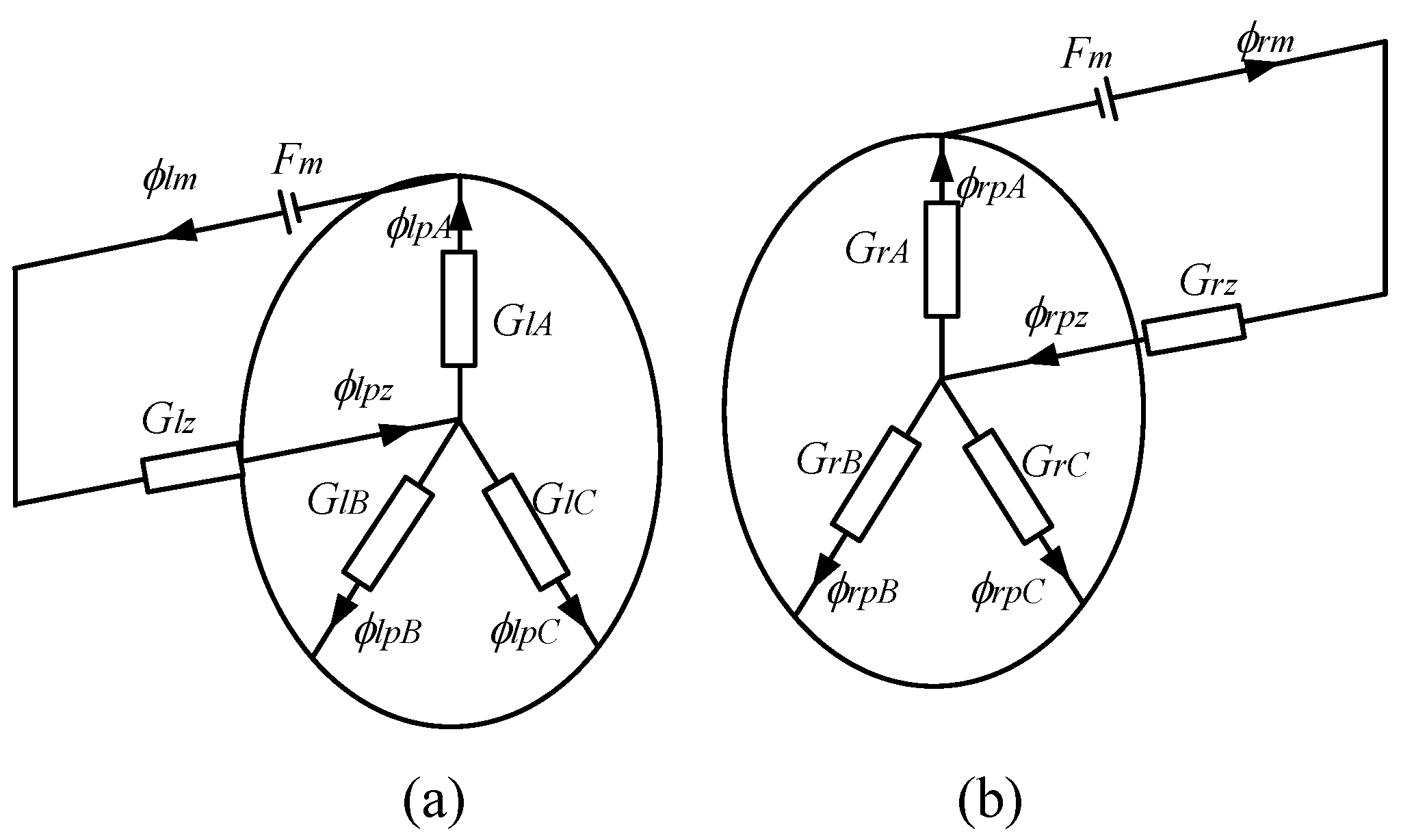
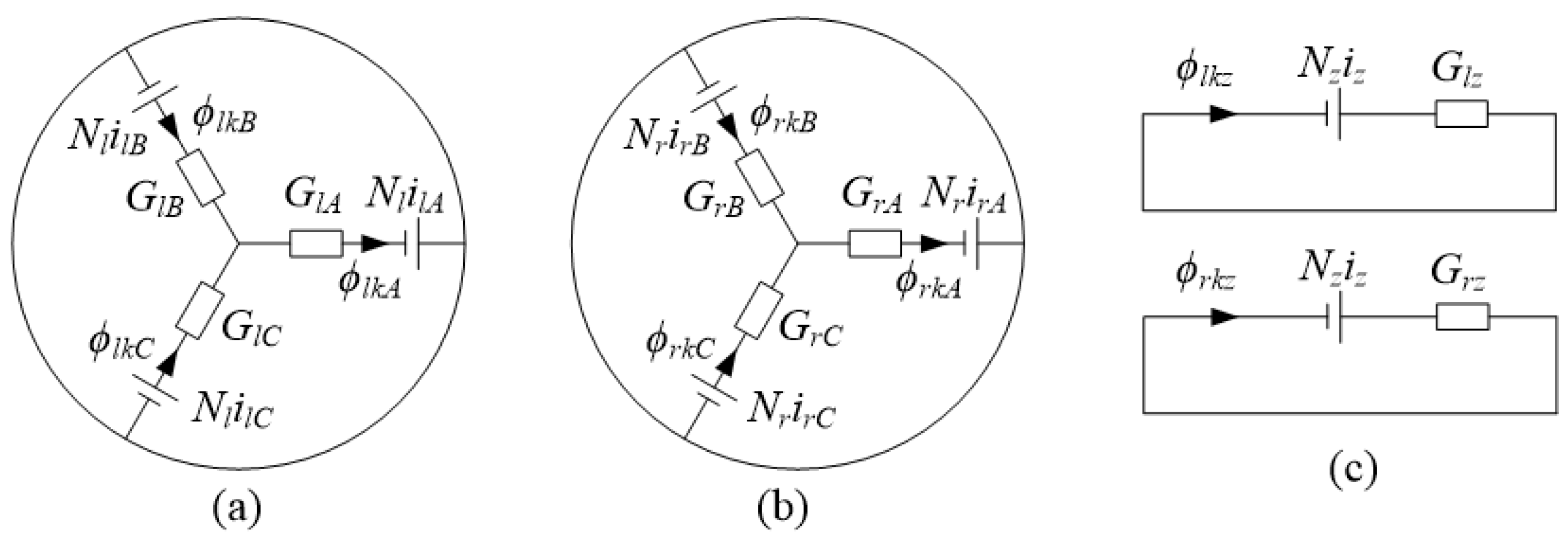
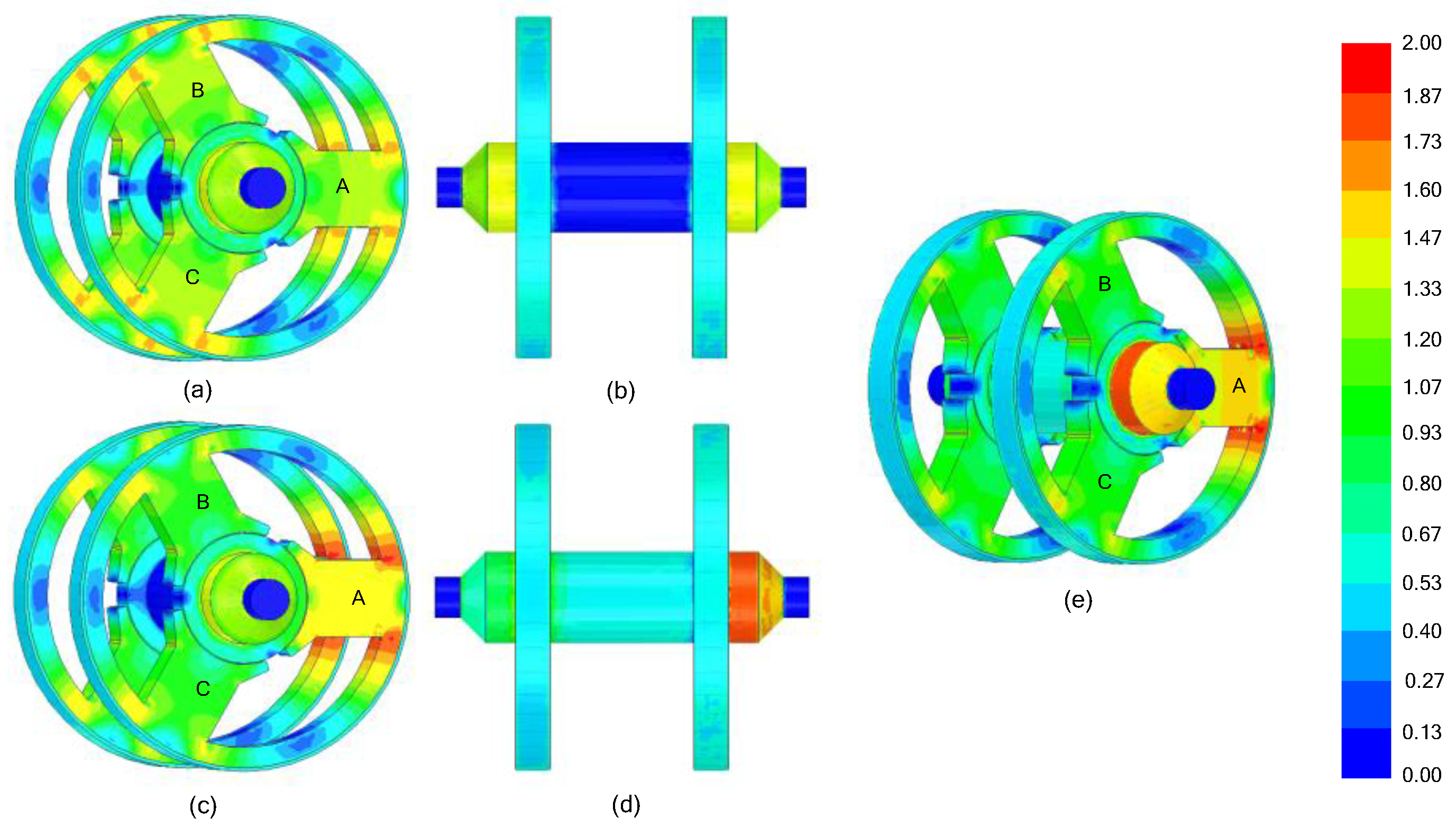
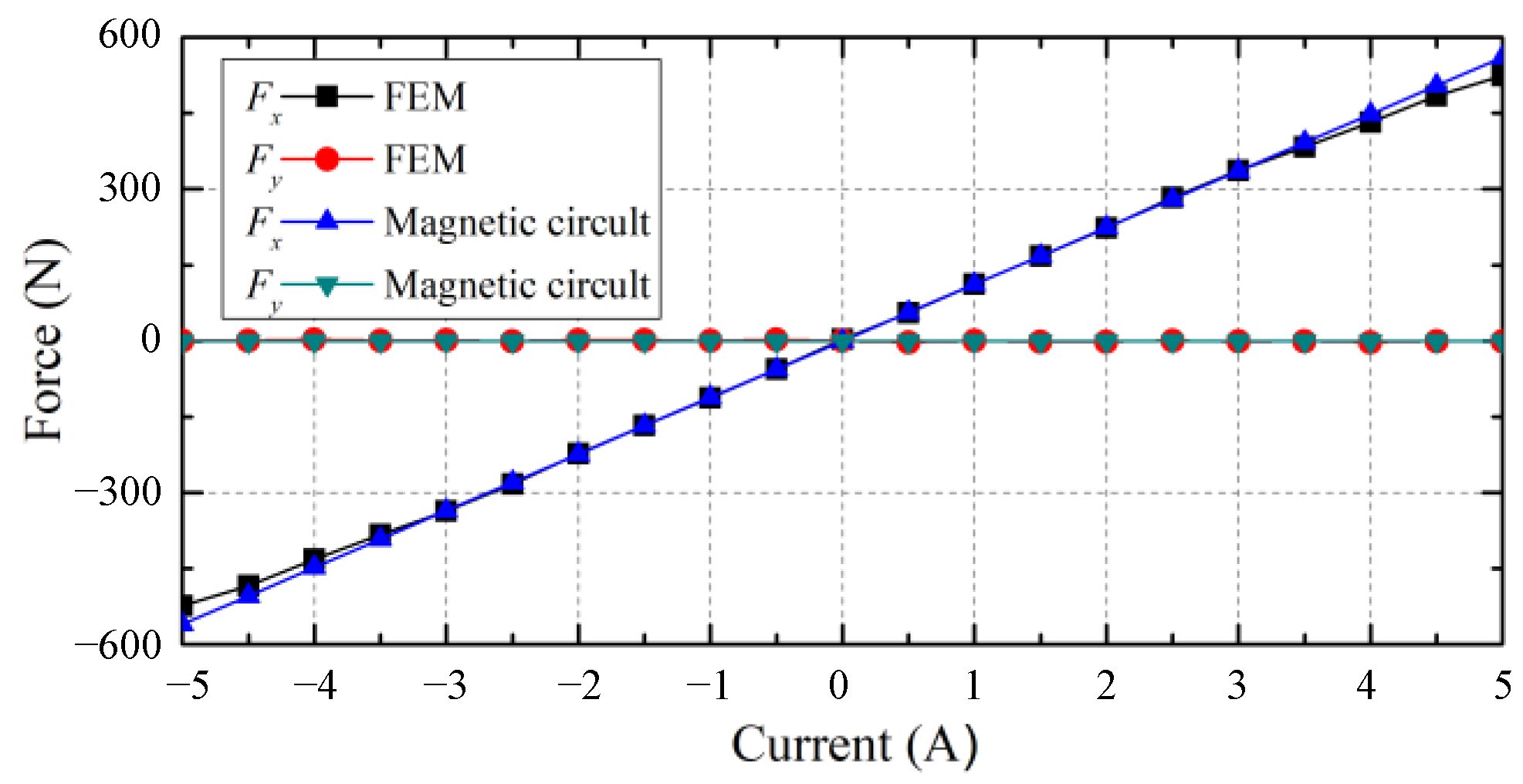

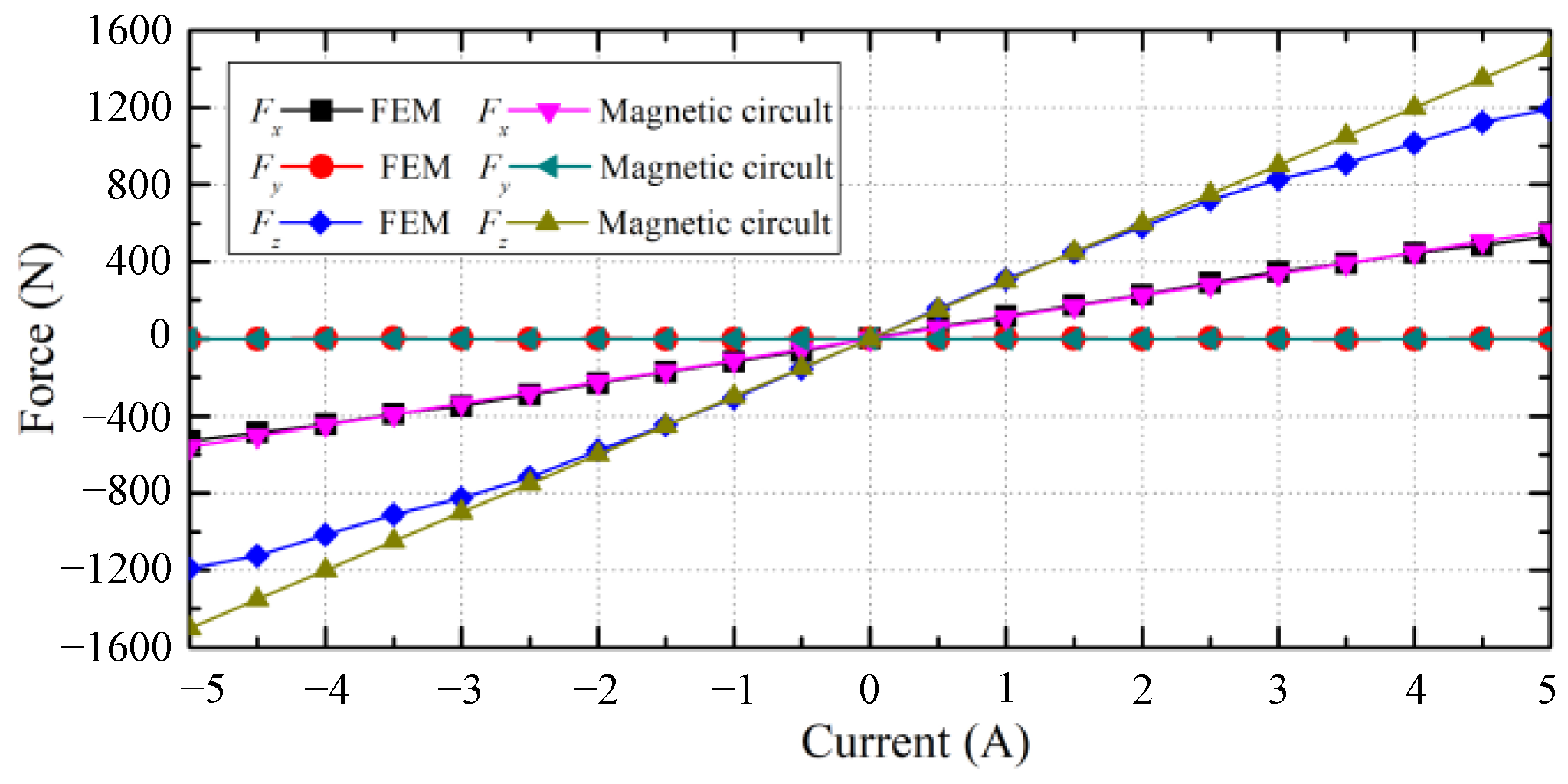
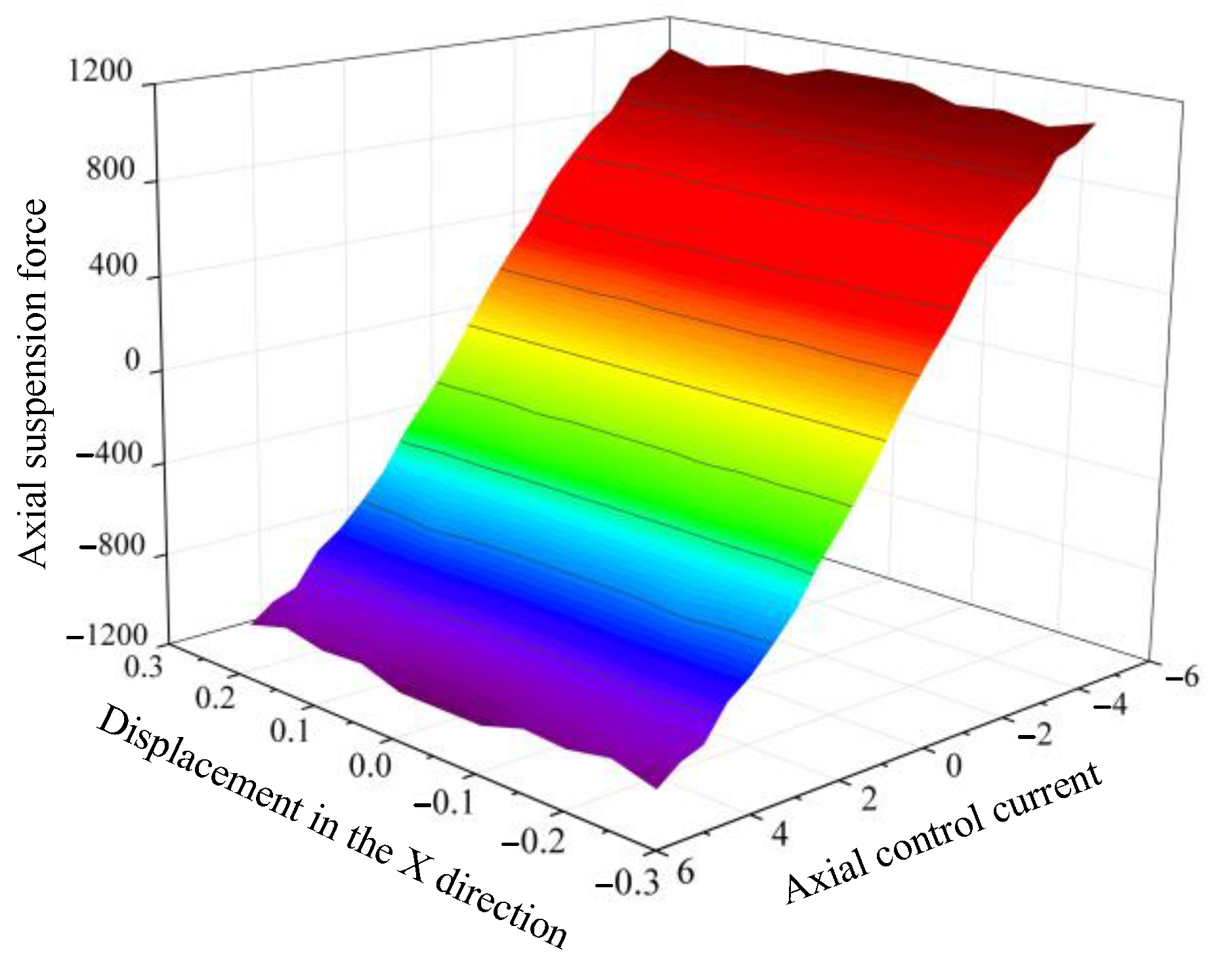
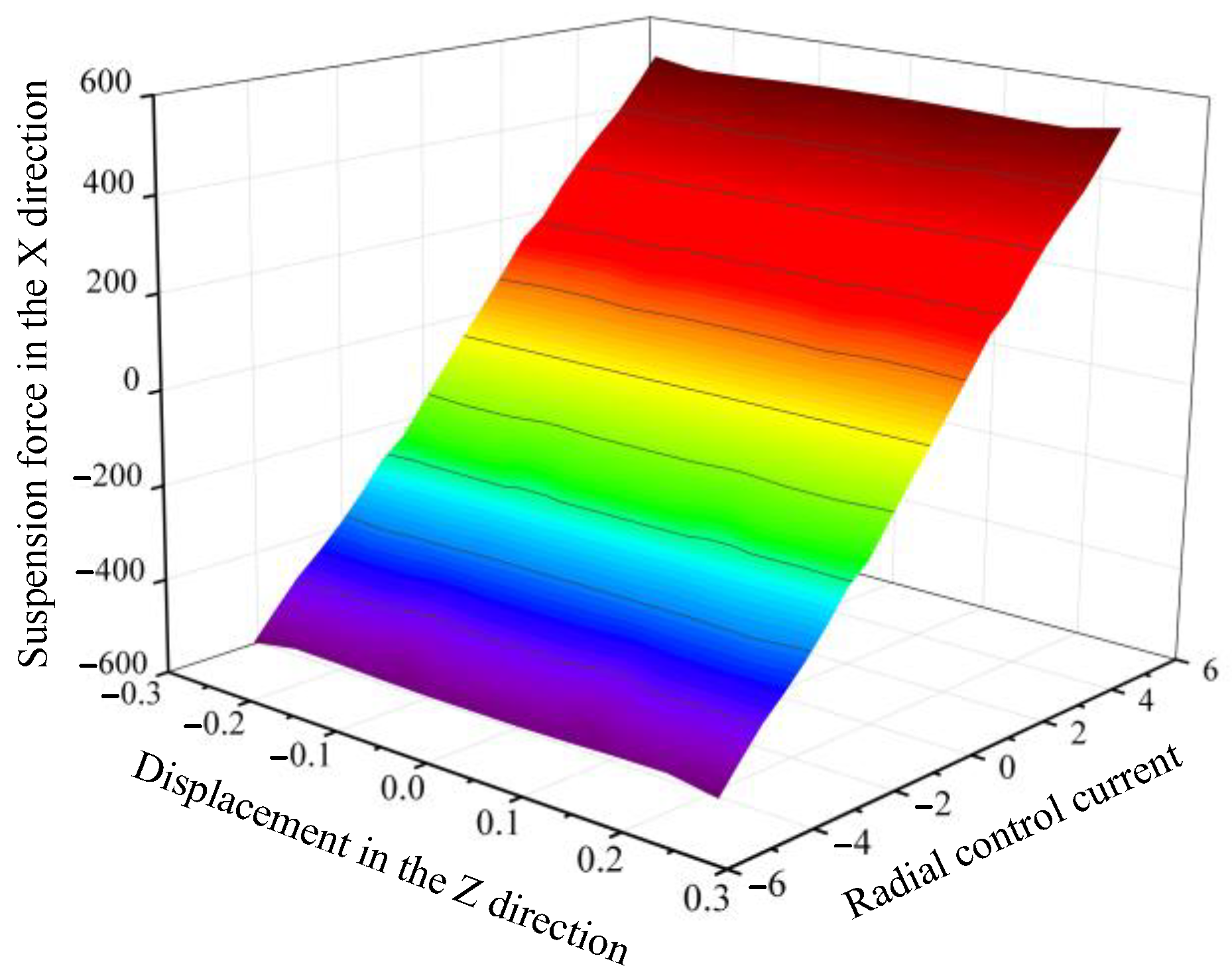
| Parameters | Value |
|---|---|
| Axial stator outer diameter | 240 mm |
| Axial stator inner diameter of | 204 mm |
| Radial stator outer diameter of | 200 mm |
| Rotor diameter | 77.2 mm |
| Axial air-gap length | 0.7 mm |
| Magnet thickness | 2 mm |
| Magnet axial length | 20 mm |
| Shaft diameter | 12 mm |
| Radial air-gap length | 1.4 mm |
| Rotor length | 190 mm |
| Angle of the inclined axial pole | 45° |
Publisher’s Note: MDPI stays neutral with regard to jurisdictional claims in published maps and institutional affiliations. |
© 2022 by the authors. Licensee MDPI, Basel, Switzerland. This article is an open access article distributed under the terms and conditions of the Creative Commons Attribution (CC BY) license (https://creativecommons.org/licenses/by/4.0/).
Share and Cite
Ye, X.; Yan, Y.; Jia, C.; Zhang, T. Modeling and Design of a Novel 5-DOF AC–DC Hybrid Magnetic Bearing. Appl. Sci. 2022, 12, 8931. https://doi.org/10.3390/app12188931
Ye X, Yan Y, Jia C, Zhang T. Modeling and Design of a Novel 5-DOF AC–DC Hybrid Magnetic Bearing. Applied Sciences. 2022; 12(18):8931. https://doi.org/10.3390/app12188931
Chicago/Turabian StyleYe, Xiaoting, Yiming Yan, Chunlai Jia, and Tao Zhang. 2022. "Modeling and Design of a Novel 5-DOF AC–DC Hybrid Magnetic Bearing" Applied Sciences 12, no. 18: 8931. https://doi.org/10.3390/app12188931
APA StyleYe, X., Yan, Y., Jia, C., & Zhang, T. (2022). Modeling and Design of a Novel 5-DOF AC–DC Hybrid Magnetic Bearing. Applied Sciences, 12(18), 8931. https://doi.org/10.3390/app12188931






